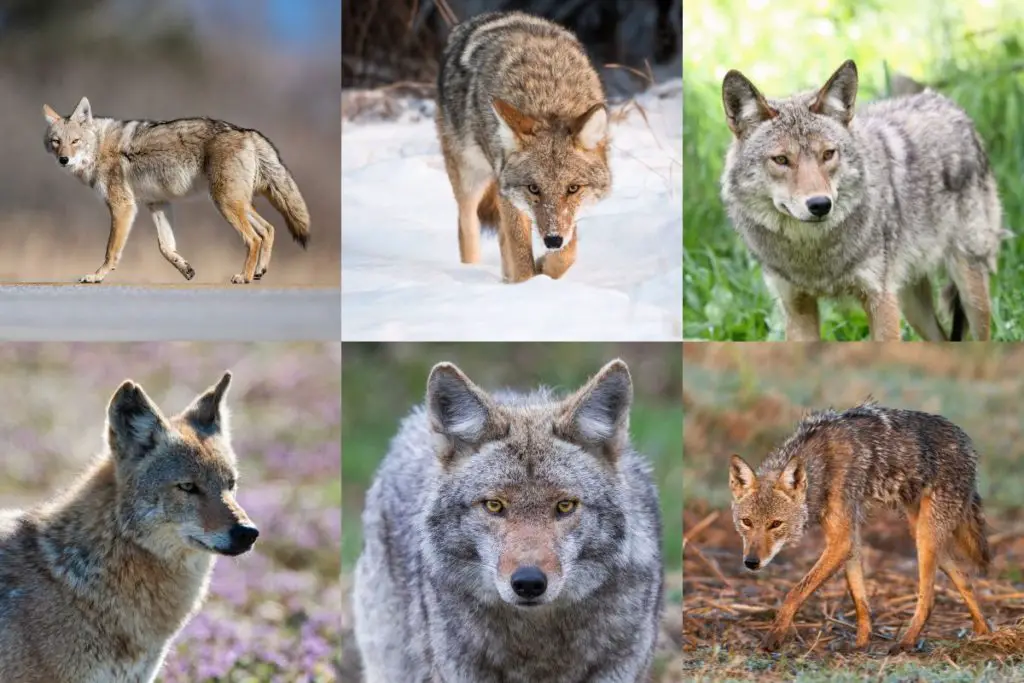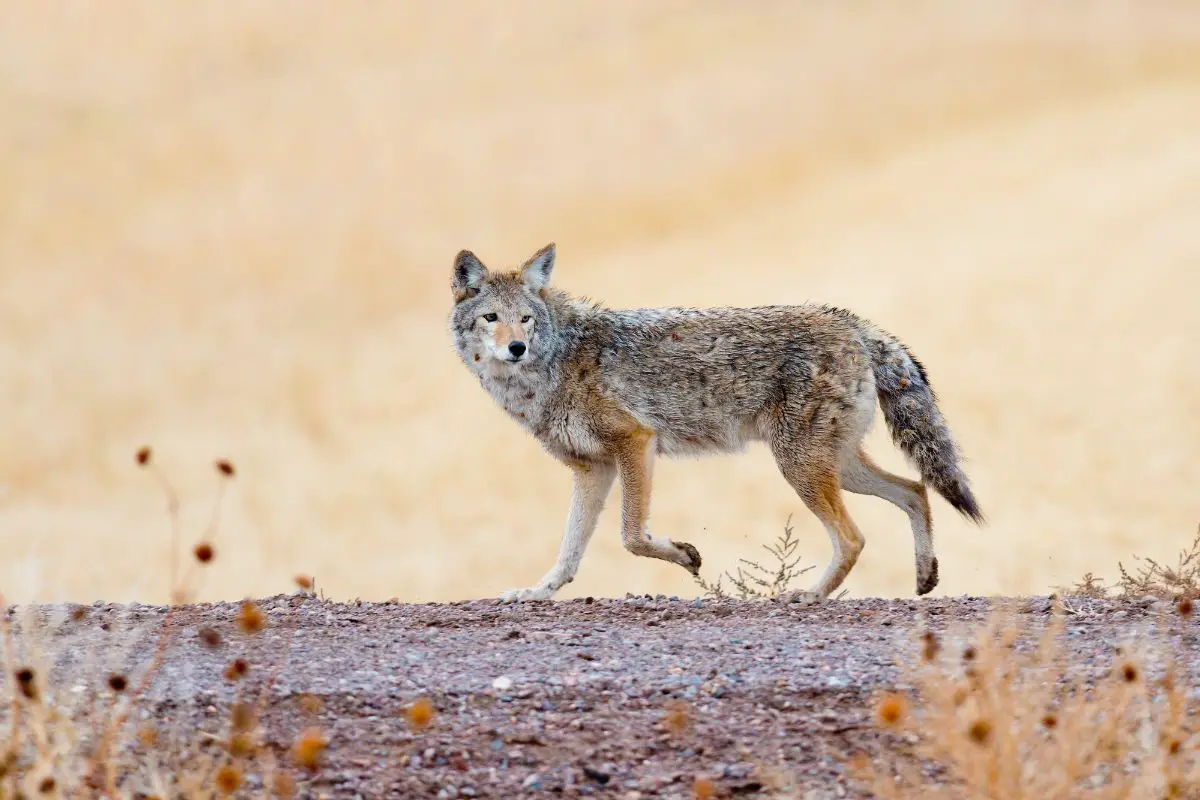Coyotes are wild canids that live throughout most of North America. They have many traits that make them recognizable, such as their colors, their size, and their behavior.
What Colors Are Coyotes?
Coyote colors consist of gray to light gray, red, and a peppered black and white mix. They have red on the tops of their nose, with white on their chin, chest, and underbellies. The colors of coyotes vary depending on the region where they live.
They come in many shapes and sizes, and their calls in the middle of the night can make the hair stand up on your arms. Knowing the colors of coyotes can help identify them.
If you think you have coyotes in your area, you should take precautions to keep yourself, your family, and your pets safe. Let’s take a closer look at the different colors that coyotes have in different regions in North America.
See our article for What Scares Coyotes
Are Coyotes Different Colors?
Coyotes can have different colors, depending on several factors, such as region, weather, type of coyote, and genetic mutations. In general, most coyotes have multiple colors, from gray, brown, red, white, and more. Coyotes have a black-tipped tail. Source.
Coyotes who live in areas where the weather is warmer may have a thinner fur coat, which could result in different coloring. While ones in colder regions may have heavier fur, where grays and tan colors are dominant.
Some coyotes have more gray, while others have a more rusty-looking color. Coyotes can sometimes be confused with other wild canids, such as foxes and wolves. However, you can usually tell the difference between them by size.
Coyote Color Chart | What Colors are Coyotes
Here is a chart I’ve put together of known colors for coyotes. These colors usually come in combinations, however, many factors are involved.
| Coyote Color Chart |
|---|
| Gray |
| Tan |
| Red |
| Salt and Pepper |
| Brown |
| Dark Brown |
| Blonde |
| Black |
| White |
Some coyotes have more of these colors than others. There are also coyotes with genetic mutations, such as melanism, that create black and dark-colored coyotes. Also, the opposite of melanism, albinism can be present in coyotes.

Eastern Coyote Colors
Eastern coyote is a type of coyote subspecies that is mixed, part coyote, part wolf. These are hybridized coyotes that take on traits of their wolf parentage. Because of this mix, they can look more like wolves than other coyotes.
They tend to be slightly larger than the average coyote, and their fur can have many different combinations. Most eastern coyotes are dark brown, gray, red, and sometimes tan or blonde with rusty colors. Source.
The eastern coyote has multiple color phases that can come out at different parts of the year. Seeing these wild canids is a special treat. You can find them on most of the east coast. They can also be found in some midwest areas.
Do Coyote Coats Change Colors?
Yes, coyote coats change colors. Many coyotes (such as eastern coyotes) have 4 color phases throughout the year. Other coyotes usually change colors with at least two of the seasons. This is summer and winter.
The summer coats of coyotes tend to be thinner. Because of this, their coats can drastically change color. They shed much of their fur, and the remaining fur can be a mix of red colors with gray.
In the winter, they get their heavy coats. Coyotes are pretty small, they have small frames. The hair that covers them tends to be long. In the winter months, the coat is the longest, at around 4-5 inches. This helps them appear to be much larger than they are, which is useful when you are competing with other predators.
Coyote Brown Colors
Many coyotes, including eastern coyotes, have brown colors. In some cases, they are dark brown or even black. Dark brown coyotes are common in eastern coyotes, where their color phases pass from dark brown, brown, to red, to blonde.
It is not unusual to see a brown or dark brown coyote. Although, most coyotes are gray, with some red. They will still have enough other characteristics to identify them as a coyote.
What Color are Coyotes in Michigan?
Coyotes in Michigan are usually gray and a reddish color. The coyotes in Michigan could be compared with the “average coyote” in color. They are going to be gray, red, and some white colors mixed in. Sometimes they will be a salt and pepper color.
There can also be an overlap in Michigan, with eastern coyotes, which are expanding territories into Midwest areas. These coyotes can sometimes have more brown and dark colors, as well as tan colors, depending on the time of year.
Rare Coyote Colors
There are some rare coyote colors. These usually happen when there is a change in season. They can lose some of their heavy fur in preparation for the summer, and more guard hairs will show through. This can make the consistency of the fur and the color appear unusual.
There are also a few rare color mutations. These are things like melanin and albinism. Some coyotes have more melanin, they look darker and can even be black. They may be partially melanistic, with blotches of black fur, or they could be completely melanistic (looking completely black.)
Can Coyotes be Black in Color?
Yes, coyotes can be black. These coyotes have a mutation called melanism. This mutation can be found in many creatures, including humans. However, it is rare with coyotes. While 25% of red foxes can be melanistic, that number is much lower in coyotes.
This condition is not local, it can happen to any coyote, in any region. It is a genetic condition. Although it is rare, you do see them in the wild. There are many videos online of people catching black coyotes on trail cams, or hunters, who have hunted them, (unfortunately.)
See When Do Coyotes Howl Here.
Related Questions
Did I see a wolf or coyote
Coyotes are smaller than wolves. If the canid was very large, it may not have been a coyote. Coyotes are usually a darker color than wolves and have a higher-pitched howl.
What color are a coyote’s eyes at night
Like many other animals in the wild, coyote eyes shine bright white when light hits them in the dark. They have night vision, and their eyes will reflect the light back.
- Hero Farm Dog Survives Epic Battle with Coyote Pack - December 9, 2024
- The 10-Minute Bedtime Routine That Changed My Dog’s Sleep Forever - November 29, 2024
- Creating a Safe Space for Nervous Pets: Your Guide to Pet-Friendly Havens - November 25, 2024

